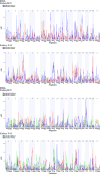Anakinra as an interleukin 1 receptor antagonist, complicated genetics and molecular impacts--from the point of view of mouse genomics
- PMID: 22425556
- PMCID: PMC4142626
- DOI: 10.1016/j.intimp.2012.02.014
Anakinra as an interleukin 1 receptor antagonist, complicated genetics and molecular impacts--from the point of view of mouse genomics
Abstract
IL-1 receptor antagonist (IL-1rn) is a protein that binds to IL-1 receptors (IL-1r1) and inhibits the binding of IL-1α and IL-1β. In recent years, IL-1rn has been implicated to be associated with many human health problems. The effects of treatment of several inflammatory disorders with anakinra, which is an interleukin-1 (IL-1) receptor antagonist, have also been reported. Both positive and negative effects have been described. In this review, we systematically analyzed the expression, correlation, and regulation of IL-1rn and its 13 partner genes using available gene expression profiles from a variety of tissues in a well known transcriptome database, Genenetwork. The 13 partner genes include IL-1r1, IL-1β, IL-1α, Myd88, Irak1, Irak2, Irak4, Traf6, Tlr4, IL-1rap, Ikbkap, Nfkb1, and Nfkb2. Gene expression profiles are from 10 tissues including spleen, kidney, lung, whole brain, eye, prefrontal cortex, cerebellum, hippocampus, striatum, and nucleus accumbens. Our analysis indicated that the interactions among IL-1rn and its partner are complex and different from tissues to tissues, suggesting a broad spectrum of the effect of IL-1rn on biological and metabolic pathways. Transcripts and protein sequences resulted from different splicing, interaction with genomic background of individuals, and environmental factors affect function of IL-1rn. At present, our knowledge on the function of IL-1rn and its partner in various tissues or organs is very limited. The long term and extended effect of anakinra on human health needs further investigations. In the future, targeted sequences or oligos of Il-1rn might be ideal for therapeutic application with less toxic and more specific in the treatment of specific disease. Detailed study on the molecular function of IL-1rn and its interaction with other genes and environmental factors is essential for development therapeutic application using IL-1rn.
Published by Elsevier B.V.
Conflict of interest statement
None.
Figures


References
-
- Carter DB, Deibel MR, Jr, Dunn CJ, Tomich CS, Laborde AL, Slightom JL, et al. Purification, cloning, expression and biological characterization of an interleukin-1 receptor antagonist protein. Nature. 1990;344:633–8. - PubMed
-
- Blakemore AI, Tarlow JK, Cork MJ, Gordon C, Emery P, Duff GW. Interleukin-1 receptor antagonist gene polymorphism as a disease severity factor in systemic lupus erythematosus. Arthritis Rheum. 1994;37:1380–5. - PubMed
-
- Mansfield JC, Holden H, Tarlow JK, Di Giovine FS, McDowell TL, Wilson AG, et al. Novel genetic association between ulcerative colitis and the anti-inflammatory cytokine interleukin-1 receptor antagonist. Gastroenterology. 1994;106:637–42. - PubMed
-
- Tarlow JK, Clay FE, Cork MJ, Blakemore AI, McDonagh AJ, Messenger AG, et al. Severity of alopecia areata is associated with a polymorphism in the interleukin-1 receptor antagonist gene. J Invest Dermatol. 1994;103:387–90. - PubMed
Publication types
MeSH terms
Substances
Grants and funding
LinkOut - more resources
Full Text Sources
Miscellaneous

